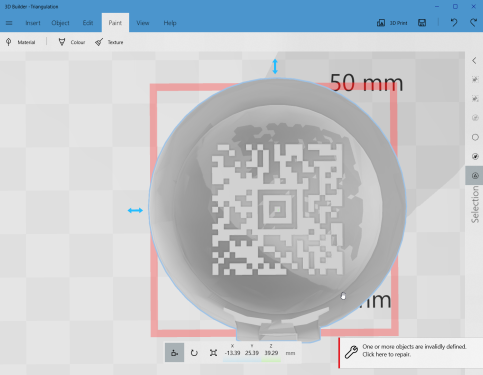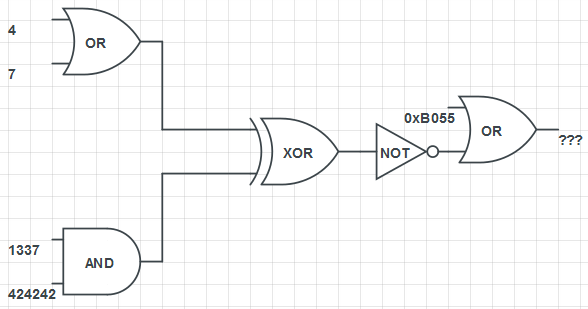#!/usr/bin/python
from z3 import *
ZV = {}
# Make solver
s = Solver()
# Everything but aekmpr is in the alphabet
for l in 'bcdfghijlnoqstuvwxyz':
ZV[l] = BitVec(l, 32)
# Limit to a single digit
for l in 'bcdfghijlnoqstuvwxyz':
s.add(ZV[l] >= 0)
s.add(ZV[l] <= 9)
# assume q != 0 (removed trivial 0 case)
s.add(ZV['q'] != 0)
# Row 1 (bytwycju + yzvyjjdy ^ vugljtyn + ugdztnwv | xbfziozy = bzuwtwol)
s.add(
(ZV['b'] * pow(10,7) + ZV['y'] * pow(10,6) + ZV['t'] * pow(10,5) + ZV['w'] * pow(10,4) + ZV['y'] * pow(10,3) + ZV['c'] * pow(10,2) + ZV['j'] * pow(10,1) + ZV['u'] * pow(10,0))
+
(ZV['y'] * pow(10,7) + ZV['z'] * pow(10,6) + ZV['v'] * pow(10,5) + ZV['y'] * pow(10,4) + ZV['j'] * pow(10,3) + ZV['j'] * pow(10,2) + ZV['d'] * pow(10,1) + ZV['y'] * pow(10,0))
^
(ZV['v'] * pow(10,7) + ZV['u'] * pow(10,6) + ZV['g'] * pow(10,5) + ZV['l'] * pow(10,4) + ZV['j'] * pow(10,3) + ZV['t'] * pow(10,2) + ZV['y'] * pow(10,1) + ZV['n'] * pow(10,0))
+
(ZV['u'] * pow(10,7) + ZV['g'] * pow(10,6) + ZV['d'] * pow(10,5) + ZV['z'] * pow(10,4) + ZV['t'] * pow(10,3) + ZV['n'] * pow(10,2) + ZV['w'] * pow(10,1) + ZV['v'] * pow(10,0))
|
(ZV['x'] * pow(10,7) + ZV['b'] * pow(10,6) + ZV['f'] * pow(10,5) + ZV['z'] * pow(10,4) + ZV['i'] * pow(10,3) + ZV['o'] * pow(10,2) + ZV['z'] * pow(10,1) + ZV['y'] * pow(10,0))
==
(ZV['b'] * pow(10,7) + ZV['z'] * pow(10,6) + ZV['u'] * pow(10,5) + ZV['w'] * pow(10,4) + ZV['t'] * pow(10,3) + ZV['w'] * pow(10,2) + ZV['o'] * pow(10,1) + ZV['l'] * pow(10,0))
)
# Row 2 (wwnnnqbw - uclfqvdu & oncycbxh | oqcnwbsd ^ cgyoyfjg = vyhyjivb)
s.add(
(ZV['w'] * pow(10,7) + ZV['w'] * pow(10,6) + ZV['n'] * pow(10,5) + ZV['n'] * pow(10,4) + ZV['n'] * pow(10,3) + ZV['q'] * pow(10,2) + ZV['b'] * pow(10,1) + ZV['w'] * pow(10,0))
-
(ZV['u'] * pow(10,7) + ZV['c'] * pow(10,6) + ZV['l'] * pow(10,5) + ZV['f'] * pow(10,4) + ZV['q'] * pow(10,3) + ZV['v'] * pow(10,2) + ZV['d'] * pow(10,1) + ZV['u'] * pow(10,0))
&
(ZV['o'] * pow(10,7) + ZV['n'] * pow(10,6) + ZV['c'] * pow(10,5) + ZV['y'] * pow(10,4) + ZV['c'] * pow(10,3) + ZV['b'] * pow(10,2) + ZV['x'] * pow(10,1) + ZV['h'] * pow(10,0))
|
(ZV['o'] * pow(10,7) + ZV['q'] * pow(10,6) + ZV['c'] * pow(10,5) + ZV['n'] * pow(10,4) + ZV['w'] * pow(10,3) + ZV['b'] * pow(10,2) + ZV['s'] * pow(10,1) + ZV['d'] * pow(10,0))
^
(ZV['c'] * pow(10,7) + ZV['g'] * pow(10,6) + ZV['y'] * pow(10,5) + ZV['o'] * pow(10,4) + ZV['y'] * pow(10,3) + ZV['f'] * pow(10,2) + ZV['j'] * pow(10,1) + ZV['g'] * pow(10,0))
==
(ZV['v'] * pow(10,7) + ZV['y'] * pow(10,6) + ZV['h'] * pow(10,5) + ZV['y'] * pow(10,4) + ZV['j'] * pow(10,3) + ZV['i'] * pow(10,2) + ZV['v'] * pow(10,1) + ZV['b'] * pow(10,0))
)
# Row 3 (yzdgotby | oigsjgoj | ttligxut - dhcqxtfw & szblgodf = sfgsoxdd)
s.add(
(ZV['y'] * pow(10,7) + ZV['z'] * pow(10,6) + ZV['d'] * pow(10,5) + ZV['g'] * pow(10,4) + ZV['o'] * pow(10,3) + ZV['t'] * pow(10,2) + ZV['b'] * pow(10,1) + ZV['y'] * pow(10,0))
|
(ZV['o'] * pow(10,7) + ZV['i'] * pow(10,6) + ZV['g'] * pow(10,5) + ZV['s'] * pow(10,4) + ZV['j'] * pow(10,3) + ZV['g'] * pow(10,2) + ZV['o'] * pow(10,1) + ZV['j'] * pow(10,0))
|
(ZV['t'] * pow(10,7) + ZV['t'] * pow(10,6) + ZV['l'] * pow(10,5) + ZV['i'] * pow(10,4) + ZV['g'] * pow(10,3) + ZV['x'] * pow(10,2) + ZV['u'] * pow(10,1) + ZV['t'] * pow(10,0))
-
(ZV['d'] * pow(10,7) + ZV['h'] * pow(10,6) + ZV['c'] * pow(10,5) + ZV['q'] * pow(10,4) + ZV['x'] * pow(10,3) + ZV['t'] * pow(10,2) + ZV['f'] * pow(10,1) + ZV['w'] * pow(10,0))
&
(ZV['s'] * pow(10,7) + ZV['z'] * pow(10,6) + ZV['b'] * pow(10,5) + ZV['l'] * pow(10,4) + ZV['g'] * pow(10,3) + ZV['o'] * pow(10,2) + ZV['d'] * pow(10,1) + ZV['f'] * pow(10,0))
==
(ZV['s'] * pow(10,7) + ZV['f'] * pow(10,6) + ZV['g'] * pow(10,5) + ZV['s'] * pow(10,4) + ZV['o'] * pow(10,3) + ZV['x'] * pow(10,2) + ZV['d'] * pow(10,1) + ZV['d'] * pow(10,0))
)
# Row 4 (nttuhlnq ^ oqbctlzh - nshtztns ^ htwizvwi + udluvhcz = syhjizjq)
s.add(
(ZV['n'] * pow(10,7) + ZV['t'] * pow(10,6) + ZV['t'] * pow(10,5) + ZV['u'] * pow(10,4) + ZV['h'] * pow(10,3) + ZV['l'] * pow(10,2) + ZV['n'] * pow(10,1) + ZV['q'] * pow(10,0))
^
(ZV['o'] * pow(10,7) + ZV['q'] * pow(10,6) + ZV['b'] * pow(10,5) + ZV['c'] * pow(10,4) + ZV['t'] * pow(10,3) + ZV['l'] * pow(10,2) + ZV['z'] * pow(10,1) + ZV['h'] * pow(10,0))
-
(ZV['n'] * pow(10,7) + ZV['s'] * pow(10,6) + ZV['h'] * pow(10,5) + ZV['t'] * pow(10,4) + ZV['z'] * pow(10,3) + ZV['t'] * pow(10,2) + ZV['n'] * pow(10,1) + ZV['s'] * pow(10,0))
^
(ZV['h'] * pow(10,7) + ZV['t'] * pow(10,6) + ZV['w'] * pow(10,5) + ZV['i'] * pow(10,4) + ZV['z'] * pow(10,3) + ZV['v'] * pow(10,2) + ZV['w'] * pow(10,1) + ZV['i'] * pow(10,0))
+
(ZV['u'] * pow(10,7) + ZV['d'] * pow(10,6) + ZV['l'] * pow(10,5) + ZV['u'] * pow(10,4) + ZV['v'] * pow(10,3) + ZV['h'] * pow(10,2) + ZV['c'] * pow(10,1) + ZV['z'] * pow(10,0))
==
(ZV['s'] * pow(10,7) + ZV['y'] * pow(10,6) + ZV['h'] * pow(10,5) + ZV['j'] * pow(10,4) + ZV['i'] * pow(10,3) + ZV['z'] * pow(10,2) + ZV['j'] * pow(10,1) + ZV['q'] * pow(10,0))
)
# Column 1 (bytwycju ^ wwnnnqbw & yzdgotby + yjjowdqh - nttuhlnq = fjivucti)
s.add(
(ZV['b'] * pow(10,7) + ZV['y'] * pow(10,6) + ZV['t'] * pow(10,5) + ZV['w'] * pow(10,4) + ZV['y'] * pow(10,3) + ZV['c'] * pow(10,2) + ZV['j'] * pow(10,1) + ZV['u'] * pow(10,0))
^
(ZV['w'] * pow(10,7) + ZV['w'] * pow(10,6) + ZV['n'] * pow(10,5) + ZV['n'] * pow(10,4) + ZV['n'] * pow(10,3) + ZV['q'] * pow(10,2) + ZV['b'] * pow(10,1) + ZV['w'] * pow(10,0))
&
(ZV['y'] * pow(10,7) + ZV['z'] * pow(10,6) + ZV['d'] * pow(10,5) + ZV['g'] * pow(10,4) + ZV['o'] * pow(10,3) + ZV['t'] * pow(10,2) + ZV['b'] * pow(10,1) + ZV['y'] * pow(10,0))
+
(ZV['y'] * pow(10,7) + ZV['j'] * pow(10,6) + ZV['j'] * pow(10,5) + ZV['o'] * pow(10,4) + ZV['w'] * pow(10,3) + ZV['d'] * pow(10,2) + ZV['q'] * pow(10,1) + ZV['h'] * pow(10,0))
-
(ZV['n'] * pow(10,7) + ZV['t'] * pow(10,6) + ZV['t'] * pow(10,5) + ZV['u'] * pow(10,4) + ZV['h'] * pow(10,3) + ZV['l'] * pow(10,2) + ZV['n'] * pow(10,1) + ZV['q'] * pow(10,0))
==
(ZV['f'] * pow(10,7) + ZV['j'] * pow(10,6) + ZV['i'] * pow(10,5) + ZV['v'] * pow(10,4) + ZV['u'] * pow(10,3) + ZV['c'] * pow(10,2) + ZV['t'] * pow(10,1) + ZV['i'] * pow(10,0))
)
# Column 2 (yzvyjjdy ^ uclfqvdu & oigsjgoj + niiqztgs - oqbctlzh = zoljwdfl)
s.add(
(ZV['y'] * pow(10,7) + ZV['z'] * pow(10,6) + ZV['v'] * pow(10,5) + ZV['y'] * pow(10,4) + ZV['j'] * pow(10,3) + ZV['j'] * pow(10,2) + ZV['d'] * pow(10,1) + ZV['y'] * pow(10,0))
^
(ZV['u'] * pow(10,7) + ZV['c'] * pow(10,6) + ZV['l'] * pow(10,5) + ZV['f'] * pow(10,4) + ZV['q'] * pow(10,3) + ZV['v'] * pow(10,2) + ZV['d'] * pow(10,1) + ZV['u'] * pow(10,0))
&
(ZV['o'] * pow(10,7) + ZV['i'] * pow(10,6) + ZV['g'] * pow(10,5) + ZV['s'] * pow(10,4) + ZV['j'] * pow(10,3) + ZV['g'] * pow(10,2) + ZV['o'] * pow(10,1) + ZV['j'] * pow(10,0))
+
(ZV['n'] * pow(10,7) + ZV['i'] * pow(10,6) + ZV['i'] * pow(10,5) + ZV['q'] * pow(10,4) + ZV['z'] * pow(10,3) + ZV['t'] * pow(10,2) + ZV['g'] * pow(10,1) + ZV['s'] * pow(10,0))
-
(ZV['o'] * pow(10,7) + ZV['q'] * pow(10,6) + ZV['b'] * pow(10,5) + ZV['c'] * pow(10,4) + ZV['t'] * pow(10,3) + ZV['l'] * pow(10,2) + ZV['z'] * pow(10,1) + ZV['h'] * pow(10,0))
==
(ZV['z'] * pow(10,7) + ZV['o'] * pow(10,6) + ZV['l'] * pow(10,5) + ZV['j'] * pow(10,4) + ZV['w'] * pow(10,3) + ZV['d'] * pow(10,2) + ZV['f'] * pow(10,1) + ZV['l'] * pow(10,0))
)
# Column 3 (vugljtyn ^ oncycbxh & ttligxut + ctvtwysu - nshtztns = sugvqgww)
s.add(
(ZV['v'] * pow(10,7) + ZV['u'] * pow(10,6) + ZV['g'] * pow(10,5) + ZV['l'] * pow(10,4) + ZV['j'] * pow(10,3) + ZV['t'] * pow(10,2) + ZV['y'] * pow(10,1) + ZV['n'] * pow(10,0))
^
(ZV['o'] * pow(10,7) + ZV['n'] * pow(10,6) + ZV['c'] * pow(10,5) + ZV['y'] * pow(10,4) + ZV['c'] * pow(10,3) + ZV['b'] * pow(10,2) + ZV['x'] * pow(10,1) + ZV['h'] * pow(10,0))
&
(ZV['t'] * pow(10,7) + ZV['t'] * pow(10,6) + ZV['l'] * pow(10,5) + ZV['i'] * pow(10,4) + ZV['g'] * pow(10,3) + ZV['x'] * pow(10,2) + ZV['u'] * pow(10,1) + ZV['t'] * pow(10,0))
+
(ZV['c'] * pow(10,7) + ZV['t'] * pow(10,6) + ZV['v'] * pow(10,5) + ZV['t'] * pow(10,4) + ZV['w'] * pow(10,3) + ZV['y'] * pow(10,2) + ZV['s'] * pow(10,1) + ZV['u'] * pow(10,0))
-
(ZV['n'] * pow(10,7) + ZV['s'] * pow(10,6) + ZV['h'] * pow(10,5) + ZV['t'] * pow(10,4) + ZV['z'] * pow(10,3) + ZV['t'] * pow(10,2) + ZV['n'] * pow(10,1) + ZV['s'] * pow(10,0))
==
(ZV['s'] * pow(10,7) + ZV['u'] * pow(10,6) + ZV['g'] * pow(10,5) + ZV['v'] * pow(10,4) + ZV['q'] * pow(10,3) + ZV['g'] * pow(10,2) + ZV['w'] * pow(10,1) + ZV['w'] * pow(10,0))
)
# Column 4 (ugdztnwv ^ oqcnwbsd & dhcqxtfw + diffhlnl - htwizvwi = uxztiywn)
s.add(
(ZV['u'] * pow(10,7) + ZV['g'] * pow(10,6) + ZV['d'] * pow(10,5) + ZV['z'] * pow(10,4) + ZV['t'] * pow(10,3) + ZV['n'] * pow(10,2) + ZV['w'] * pow(10,1) + ZV['v'] * pow(10,0))
^
(ZV['o'] * pow(10,7) + ZV['q'] * pow(10,6) + ZV['c'] * pow(10,5) + ZV['n'] * pow(10,4) + ZV['w'] * pow(10,3) + ZV['b'] * pow(10,2) + ZV['s'] * pow(10,1) + ZV['d'] * pow(10,0))
&
(ZV['d'] * pow(10,7) + ZV['h'] * pow(10,6) + ZV['c'] * pow(10,5) + ZV['q'] * pow(10,4) + ZV['x'] * pow(10,3) + ZV['t'] * pow(10,2) + ZV['f'] * pow(10,1) + ZV['w'] * pow(10,0))
+
(ZV['d'] * pow(10,7) + ZV['i'] * pow(10,6) + ZV['f'] * pow(10,5) + ZV['f'] * pow(10,4) + ZV['h'] * pow(10,3) + ZV['l'] * pow(10,2) + ZV['n'] * pow(10,1) + ZV['l'] * pow(10,0))
-
(ZV['h'] * pow(10,7) + ZV['t'] * pow(10,6) + ZV['w'] * pow(10,5) + ZV['i'] * pow(10,4) + ZV['z'] * pow(10,3) + ZV['v'] * pow(10,2) + ZV['w'] * pow(10,1) + ZV['i'] * pow(10,0))
==
(ZV['u'] * pow(10,7) + ZV['x'] * pow(10,6) + ZV['z'] * pow(10,5) + ZV['t'] * pow(10,4) + ZV['i'] * pow(10,3) + ZV['y'] * pow(10,2) + ZV['w'] * pow(10,1) + ZV['n'] * pow(10,0))
)
# Column 5 (xbfziozy ^ cgyoyfjg & szblgodf + thhwohwn - udluvhcz = jqxizzxq)
s.add(
(ZV['x'] * pow(10,7) + ZV['b'] * pow(10,6) + ZV['f'] * pow(10,5) + ZV['z'] * pow(10,4) + ZV['i'] * pow(10,3) + ZV['o'] * pow(10,2) + ZV['z'] * pow(10,1) + ZV['y'] * pow(10,0))
^
(ZV['c'] * pow(10,7) + ZV['g'] * pow(10,6) + ZV['y'] * pow(10,5) + ZV['o'] * pow(10,4) + ZV['y'] * pow(10,3) + ZV['f'] * pow(10,2) + ZV['j'] * pow(10,1) + ZV['g'] * pow(10,0))
&
(ZV['s'] * pow(10,7) + ZV['z'] * pow(10,6) + ZV['b'] * pow(10,5) + ZV['l'] * pow(10,4) + ZV['g'] * pow(10,3) + ZV['o'] * pow(10,2) + ZV['d'] * pow(10,1) + ZV['f'] * pow(10,0))
+
(ZV['t'] * pow(10,7) + ZV['h'] * pow(10,6) + ZV['h'] * pow(10,5) + ZV['w'] * pow(10,4) + ZV['o'] * pow(10,3) + ZV['h'] * pow(10,2) + ZV['w'] * pow(10,1) + ZV['n'] * pow(10,0))
-
(ZV['u'] * pow(10,7) + ZV['d'] * pow(10,6) + ZV['l'] * pow(10,5) + ZV['u'] * pow(10,4) + ZV['v'] * pow(10,3) + ZV['h'] * pow(10,2) + ZV['c'] * pow(10,1) + ZV['z'] * pow(10,0))
==
(ZV['j'] * pow(10,7) + ZV['q'] * pow(10,6) + ZV['x'] * pow(10,5) + ZV['i'] * pow(10,4) + ZV['z'] * pow(10,3) + ZV['z'] * pow(10,2) + ZV['x'] * pow(10,1) + ZV['q'] * pow(10,0))
)
# Print answers
print(s.check())
print(s.model())









